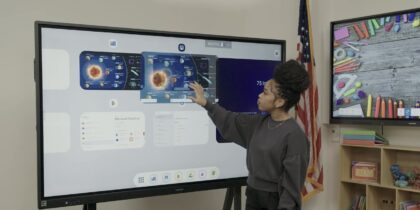The shift toward blended learning is well underway in higher education, with more than two-thirds of faculty saying they’ve used or would like to use adaptive learning tools in their curriculum. Campus leaders have taken various approaches to make sure their students have appropriate digital devices that can access these tools for instruction.
Blended learning is an educational model in which students learn partly through face-to-face interaction with their instructor and partly through online or digital instruction, with some element of control over the time, place, path or pace of their learning. It combines the best of both methods in ways that can personalize learning and make content more accessible for students. For instance, students can use adaptive learning software that hones in on their specific skills and delivers highly targeted lessons that aim to fill the gaps in their instruction.
A Changing Landscape
In the early days of personal computing, many colleges and universities set their own computing standards, says Kenneth C. Green, founding director of the Campus Computing Project. Some forged agreements with “preferred providers” and recommended that students bring only certain devices to campus, while others bundled the cost of a particular device into students’ tuition. But the higher-education computing environment is changing, Green says. As campus IT leaders look to support blended learning, many are abandoning these older approaches in favor of “bring your own device” (BYOD) programs, in which colleges and universities aim to accommodate any student-owned device.
“This is not 1986 or even 1996, and students are coming to campus having already had experience with a whole range of technologies,” Green says. “Most full-time undergraduates have smartphones or tablets before they even get to college.” As a result, campus IT leaders are creating open environments that seek to leverage the devices students already have.
Enter BYOD
A BYOD program creates a number of challenges for colleges and universities. For instance, campus IT leaders must design their networks in a way that provides universal yet secure access to any student device. Faculty must choose blended learning resources that students can access on a wide range of devices and platforms. And campus administrators must keep in mind that some students still might not own a laptop, tablet or other digital device.
Liberty University in Lynchburg, Virginia, has addressed these challenges head on. “With everything we do, we think: How can all students benefit, regardless of the device they use?” says Joshua Frejosky, Liberty’s director of IT communications. Liberty University has taken a two-pronged approach to device usage on its campus. The first of these strategies is a BYOD program in which students are encouraged to bring whatever device they already own, and “we will make sure you can get it on our network,” Frejosky says. The second strategy is an “IT marketplace” that helps students acquire new devices for use on campus. Liberty has partnered with several manufacturers to give students discounts on a wide range of devices; an agreement with Samsung, for instance, allows students to buy Galaxy tablets at a special student rate. “We are opening a tech store on campus where we can sell these devices directly to students at the discounted rate.”
Liberty University instructors choose resources for blended learning that are browser-based, so students can use these resources on any device with a web browser. Students and instructors in some courses are using an innovative software program called Tidebreak to facilitate greater collaboration, enabling students to share their work and co-create content no matter what device they might be using. What’s more, campus IT leaders have segmented the university’s network so that students can access the network from any device, but the network for the BYOD initiative is separate from the university’s other systems.
“We never want to tell students or faculty, ‘You’ve made an investment in a certain device, but sorry, we’re not going to allow that here,'” Frejosky says. “We fixed that problem with our underlying network infrastructure, as opposed to enforcing a rule on our students or faculty.”
Learn more about the newest laptop, tablet and 2-in-1 options available to students and educators.







